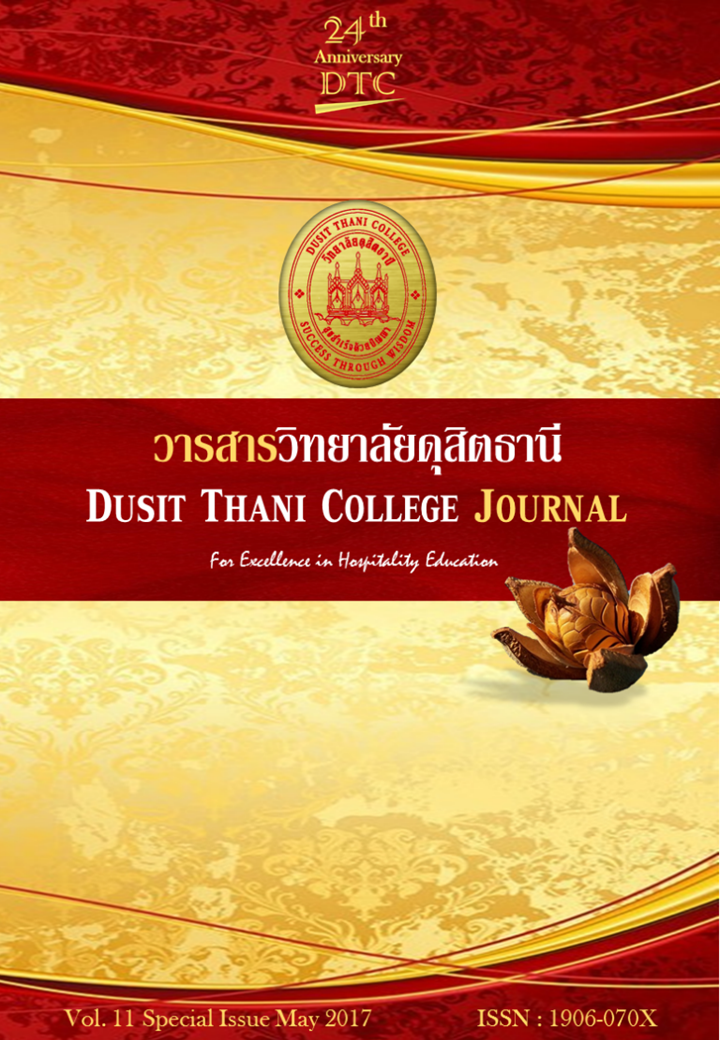แนวคิดสีเขียวเพื่อกลยุทธ์ทางการตลาด กรณีศึกษาโรงแรมรอยัล ปริ้นเซส หลานหลวง กรุงเทพ
Main Article Content
บทคัดย่อ
จุดประสงค์ของการวิจัยนี้คือ การศึกษาประโยชน์ของการใช้แนวคิดสีเขียว เพื่อให้เป็นข้อได้เปรียบในการแข่งขันทางการตลาดของธุรกิจโรงแรมในกรณีศึกษา โรงแรมรอยัล ปริ้นเซส หลานหลวง กรุงเทพมหานคร ระเบียบวิธีการวิจัยในครั้งนี้ ใช้การสัมภาษณ์ผู้เชี่ยวชาญในธุรกิจโรงแรม องค์กรการท่องเที่ยว และมูลนิธิใบไม้เขียวของประเทศไทย ผลการวิจัยพบว่า การที่ธุรกิจโรงแรมใช้แนวคิดสีเขียวในการบริหารจัดการโรงแรม ทำให้เกิดประโยชน์ต่าง ๆ อาทิ สร้างภาพลักษณ์ที่ดีและชื่อเสียงในเชิงบวกในการอนุรักษ์สิ่งแวดล้อม อีกทั้งยังสามารถลดต้นทุนการบริหารจัดการโรงแรม ซึ่งถือได้ว่าเป็นกลยุทธ์ทางการตลาดที่ดี และมีผลต่อมุมมองของผู้ใช้บริการที่มีต่อองค์กร
Article Details
รูปแบบการอ้างอิง
Akruthai La เ. . ล., Patranit Weerachaleepat ภ. . ว., & Rattanawadee Patcharapuwadol ร. . พ. (2018). แนวคิดสีเขียวเพื่อกลยุทธ์ทางการตลาด กรณีศึกษาโรงแรมรอยัล ปริ้นเซส หลานหลวง กรุงเทพ. วารสารวิทยาลัยดุสิตธานี, 11(special), 186–197. สืบค้น จาก https://so01.tci-thaijo.org/index.php/journaldtc/article/view/136150
ประเภทบทความ
บทความวิจัย
นโยบายการพิจารณากลั่นกรองบทความ
- บทความวิจัยและบทความวิชาการทุกเรื่องที่จะได้รับการตีพิมพ์ต้องผ่านการพิจารณากลั่นกรองโดยผู้ทรงคุณวุฒิ (Peer Review) ในสาขาที่เกี่ยวข้อง จำนวน 3 ท่าน/บทความ
- บทความ ข้อความ ภาพประกอบและตารางประกอบที่ลงตีพิมพ์ในวารสารเป็นความคิดเห็นส่วนตัวของผู้เขียน กองบรรณาธิการไม่จำเป็นต้องเห็นด้วยเสมอไป และไม่มีส่วนรับผิดชอบใด ๆ ถือเป็นความรับผิดชอบของผู้เขียนแต่เพียงผู้เดียว
- บทความที่จะได้รับการตีพิมพ์จะต้องไม่เคยตีพิมพ์ เผยแพร่ที่ใดมาก่อน และไม่อยู่ระหว่างการพิจารณาของวารสารฉบับอื่น หากตรวจสอบพบว่ามีการตีพิมพ์ซ้ำซ้อน ถือเป็นความรับผิดชอบของผู้เขียนแต่เพียงผู้เดียว
- บทความใดที่ผู้อ่านเห็นว่าได้มีการลอกเลียนหรือแอบอ้างโดยปราศจากการอ้างอิง หรือทำให้เข้าใจผิดว่าเป็นผลงานของผู้เขียน กรุณาแจ้งให้กองบรรณาธิการวารสารทราบจะเป็นพระคุณยิ่ง
เอกสารอ้างอิง
Ashrafi, M. (2014). Green Marketing in Hospitality Industry Journal of Applied Environmental, 42-46.
Cramer, J. (1993). Environmental management: From “fit” to “stretch”. Business Strategy and the environment, 7(3), 162-172.
Eadington, W.R. & Redman, M. (1991). Economics and tourism. Annual of Tourism Research, 18, 41-56. Cited in Lee, C.-K; T. Var; & T.W. Blaine (1996). Determinant of inbound tourist expenditures. Annual of Tourism Research, 23(3), 527-542.
Ernst and Young. (2008). Hospitality Going Green. Global Hospitality Insights A Publication for the hositality Industry, 1-13.
Gornert, S. (2004). “Perception about parks and ecotourism: German and Canadian tourists compared.” Textual Studies in Canada.
Graci, S. & Dodds, R. (2008). Why go green? The business case for environment commitment in the Canadian hotel industry. Anatolia: An International Journal of Tourism and Hospitality Research, 19(2), 251-270.
Green Leaf Foundation. (2007, 11 12). Green Leaf Foundation. Retrieved from Green Leaf Foundation: https://www.greenleafthai.org/en/green_news/news/detail.php?ID=841
Jantraprap, V. (2016, January 6). Thailand expects record tourist arrivals in 2016. Retrieved from https://www.reuters.com/article/us-thailand-tourism-idUSKBN0UK0IU20160106.
James, P. (1994). Business environment performance measurement. Business Strategy and the environment, 3(2), 59-67.
Masau P. & Prideaux B. (2003). Sustainable tourism: A role for Kenya’s hotel industry. Current Issues in Tourism, 6(3), 197-208.
Royal Princess Larn Luang, Bangkok. (2012). Royal Princess Larn Luang Bangkok. Retrieved from https://www.royalprincesslarnluang.com/index.html.
Scowsill, D. (2015). Travel & Tourism Economic Impact. Bangkok: World Travel and Tourism Council.
Tourism Authority of Thailand. (2008). Tourism in Thailand.” Retrieved from https://www2.tat.or.th/stat/web/static_index.php
United Nations. (2012). Review of implementation of Agenda 21 and the Rio Principles. United Nations.
Cramer, J. (1993). Environmental management: From “fit” to “stretch”. Business Strategy and the environment, 7(3), 162-172.
Eadington, W.R. & Redman, M. (1991). Economics and tourism. Annual of Tourism Research, 18, 41-56. Cited in Lee, C.-K; T. Var; & T.W. Blaine (1996). Determinant of inbound tourist expenditures. Annual of Tourism Research, 23(3), 527-542.
Ernst and Young. (2008). Hospitality Going Green. Global Hospitality Insights A Publication for the hositality Industry, 1-13.
Gornert, S. (2004). “Perception about parks and ecotourism: German and Canadian tourists compared.” Textual Studies in Canada.
Graci, S. & Dodds, R. (2008). Why go green? The business case for environment commitment in the Canadian hotel industry. Anatolia: An International Journal of Tourism and Hospitality Research, 19(2), 251-270.
Green Leaf Foundation. (2007, 11 12). Green Leaf Foundation. Retrieved from Green Leaf Foundation: https://www.greenleafthai.org/en/green_news/news/detail.php?ID=841
Jantraprap, V. (2016, January 6). Thailand expects record tourist arrivals in 2016. Retrieved from https://www.reuters.com/article/us-thailand-tourism-idUSKBN0UK0IU20160106.
James, P. (1994). Business environment performance measurement. Business Strategy and the environment, 3(2), 59-67.
Masau P. & Prideaux B. (2003). Sustainable tourism: A role for Kenya’s hotel industry. Current Issues in Tourism, 6(3), 197-208.
Royal Princess Larn Luang, Bangkok. (2012). Royal Princess Larn Luang Bangkok. Retrieved from https://www.royalprincesslarnluang.com/index.html.
Scowsill, D. (2015). Travel & Tourism Economic Impact. Bangkok: World Travel and Tourism Council.
Tourism Authority of Thailand. (2008). Tourism in Thailand.” Retrieved from https://www2.tat.or.th/stat/web/static_index.php
United Nations. (2012). Review of implementation of Agenda 21 and the Rio Principles. United Nations.


